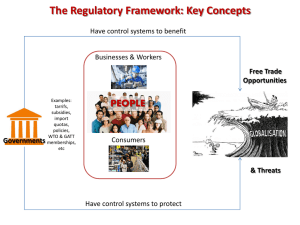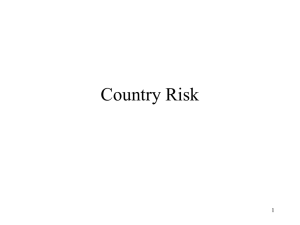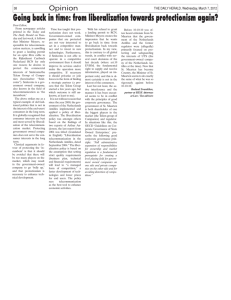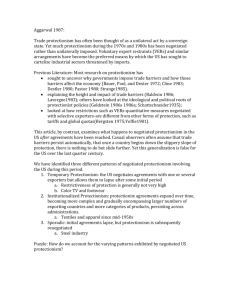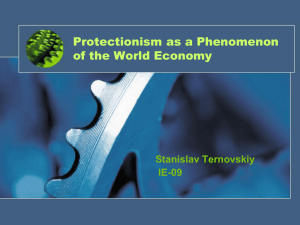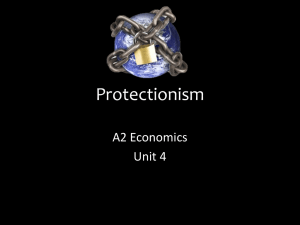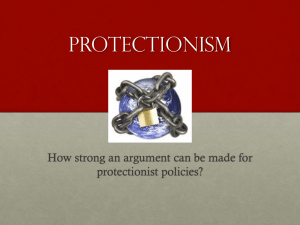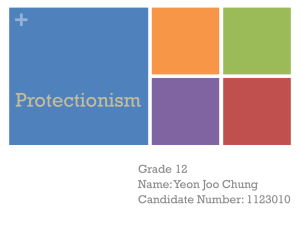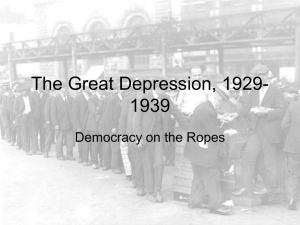eu trade policy and developing countries
advertisement
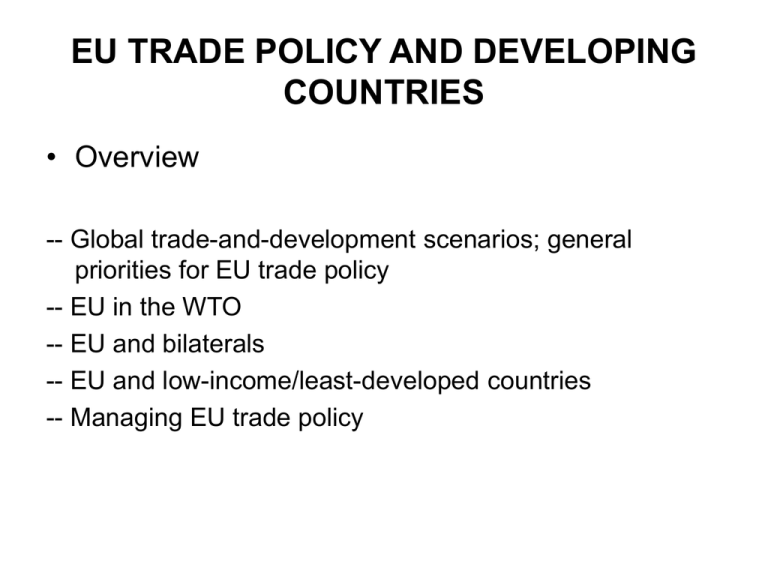
EU TRADE POLICY AND DEVELOPING COUNTRIES • Overview -- Global trade-and-development scenarios; general priorities for EU trade policy -- EU in the WTO -- EU and bilaterals -- EU and low-income/least-developed countries -- Managing EU trade policy EU TRADE POLICY AND DEVELOPING COUNTRIES • Global trade-and-development scenarios -- Crisis aftermath: anaemic West; bullish emerging markets; shift to the East GDP Growth and Growth Estimates 2008 2009 2010 Advanced economies 0.556 -3.432 1.323 Africa 5.183 1.694 4.028 Developing Asia 7.585 6.205 7.347 Western Hemisphere 4.172 -2.534 2.901 International Monetary Fund, World Economic Outlook Database, October 2009 World Trade Goods and Services Trade Volumes 2008 2009 2010 Import Export Import Export Import Export 0.5 1.9 -13.7 -13.6 1.2 2.0 11.2 -0.5 -1.7 -4.9 5.0 4.2 Developing Asia 6.9 6.5 -7.0 -8.1 5.3 3.3 Western Hemisphere 7.4 3.1 -11.2 -6.7 3.6 2.7 Advanced economies Africa International Monetary Fund, World Economic Outlook Database, October 2009 Growth in Industrial Production (2005-2009) Growth in Merchandise Exports (2005-2009) FDI inflows, global and by groups of economies, 1980-2008 (billions of dollars) EU TRADE POLICY AND DEVELOPING COUNTRIES • Three scenarios for the world economy -- Reglobalisation -- Deglobalisation -- Anaemic recovery EU TRADE POLICY AND DEVELOPING COUNTRIES • Reglobalisation Strong and adaptive economic systems – and efficient stimulus packages – shortened the crisis and speeded up recovery -- Recovery cycle; then strong globalisation -- Similarities with the late 1990s rather than the noughties -- Geographical equalisation of trade and growth -- Horizontal and vertical integration -- Trade and FDI expansion drivers of growth -- Technological development and policy liberalisation EU TRADE POLICY AND DEVELOPING COUNTRIES • Deglobalisation Cyclical deglobalisation succeeded by structural deglobalisation through policy interventions. -- Stimulus activities not effective; inflation; end to deflationary effect of globalisation -- Creeping protectionism enforced by new wave of factor market interventions at home; 1930s style fragmentation -- Short recovery cycle that ends when stimulus packages are phased out; new dip in 2012-2014 -- Trade and FDI never rebound fully; supply-chain collapse -- Spiralling protectionism -- Positive growth in China; Eursclerosis; US inflation cycle; negative growth in commodity countries EU TRADE POLICY AND DEVELOPING COUNTRIES • Anaemic recovery -- A lost decade for trade and growth; creeping protectionism and structural problems keep the world economy at low growth rates -- Similarities with the 1970s and early 1980s -- Creeping protectionism and domestic market interventions -- Slow trade and FDI growth -- Globalisation angst -- The return of industrial policy -- China’s and India’s growth slows down (6%), OECD and ACP very low growth (+/- 1%) Annual average growth of trade as part of GDP Annual average growth of trade as part of GDP Source: UNCTAD Statistical Handbook EU TRADE POLICY AND DEVELOPING COUNTRIES • Anaemic recovery (cont.) -- Domestic crisis interventions (bailouts, fiscal stimulus): macroeconomic consequences cloud horizon for developing countries -- Return to Big Government: new interventions in product and factor markets distort competition -- Spillover to regulatory protectionism Scenarios for the global economy and trade policy Reglobalisation Economy. Buoyant global economy driven by globalisation. Strong horizontal integration, especially through emerging markets. Strong cross-border vertical integration through supply-chain production networks. New wave of policy liberalisation drives globalisation and growth. Trade policy. Benign conditions for trade liberalisation. The Doha Round finishes soon in the new decade, followed by an ambitious post-Doha agenda of liberalisation and rule-strengthening. Regionalisation and plurilateralisation of PTAs. Harmonisation and simplification of ROOs. Revived unilateral liberalisation of trade and investments, freeing up trade in services in particular. Trade-related structural reforms in OECD and emerging markets. Deglobalisation Economy. Global economic contraction. Short periods of small growth. Regionalisation and relocalisation of production as global supply chains unravel. Trade policy. Malign conditions for trade policy. Doha Round dead and buried and no post-Doha agenda. Huge strains on WTO dispute settlement. Marginalisation of WTO. Big-power driven PTAs. PTAs are inward-looking and trade-restrictive. Formation of clashing regional blocs. Escalating unilateral protectionism. Scenarios for the global economy and trade policy (cont.) Anaemic Economy. Economic growth patchy and uneven. A decade of volatility, also for trade and FDI. Expansion initially in Asia, but at a slower pace. Eurosclerosis. Recovery American and UK quagmire. Japanese malaise.. Trade policy. Trade policy generally defensive and closely related to the business cycle and overall macro conditions. Continued drift and decline of the WTO. Proliferation of weak, trade-light PTAs. More trade/investment diversion and spaghetti/noodle bowls. More domestic interventions in capital, labour and product markets. Creeping regulatory protectionism increases, e.g. green protectionism. EU TRADE POLICY AND DEVELOPING COUNTRIES Emerging protectionism: v. little up-front protectionism; rather creeping regulatory protectionism - Tariffs - Import licensing Financial mercantilism Subsidies “Buy national” measures Foreign-investment restrictions Migrant labour Anti-dumping duties Standards protectionism, including climate change China-bashing • Domestic economic policy and trade policy are linked: lessons from previous eras EU TRADE POLICY AND DEVELOPING COUNTRIES • EU trade policy -- Link between Single Market and external trade policy -- Crisis aftermath: Single Market under stress; defensiveness abroad EU TRADE POLICY AND DEVELOPING COUNTRIES • EU trade-policy priorities -- Must prioritise -- First priority: EU commercial interests -- Equal priority: Single Market – contain internal protectionism and further liberalisation/structural reforms EU TRADE POLICY AND DEVELOPING COUNTRIES • EU in the WTO -- EU should lead initiative to conclude a v. modest Doha Round -- EU should lead strategic thinking on post-Doha priorities (market access, rules, flexible decision-making) -- Emphasise market access, rules and plurilateral agreements where economic gains are largest -- Development dimension is market access and rules, not exemptions, old-style S&D and aid (as in DDA) EU TRADE POLICY AND DEVELOPING COUNTRIES • EU and bilaterals -- Prioritise key commercial partners -- Rhetoric but only half-reality of Global Europe -- USA, Japan and China -- Deep-integration FTAs; liberalisation and structural reform at both ends; open regionalism EU (27) Trade Partners Goods, Excluding the EU Exports Destination Imports Annual percentage Origin change Value Share 2008 2008 2007 2008 World 1924.9 100.0 16 10 1. US 362.7 18.8 6 2. Russia 153.2 8.0 3. Switzerland 143.7 4. China Annual percentage change Value Share 2008 2008 2007 2008 World 2282.2 100.0 16 12 2 1. China 363.7 15.9 30 15 34 27 2. US 268.3 11.8 13 8 7.5 15 13 3. Russia 254.0 11.1 11 28 113.7 5.9 23 17 4. Norway 135.3 5.9 6 29 5. Turkey 79.8 4.1 15 11 5. Switzerland 117.8 5.2 17 12 6. Norway 64.3 3.3 24 8 6. Japan 109.9 4.8 11 2 7. Japan 60.4 3.1 6 3 7. Turkey 67.5 3.0 23 5 8. UAE 46.6 2.4 16 27 8. Korea 57.9 2.5 11 2 9. India 45.6 2.4 32 15 9. Brazil 52.1 2.3 31 16 10. Canada 38.4 2.0 6 8 10. Libya 50.3 2.2 15 34 Source: World Trade Organization, International Trade Statistics, 2009. EU (27) Trade Partners Services, Excluding the EU Exports Imports Value Share Annual percentage change Value Share Annual percentage change 2007 2007 2004-07 2006 2007 Origin 2007 2007 2004-07 2006 2007 World 668280 100.0 14 13 21 World 548024 100.0 12 10 19 1. US 186557 27.9 10 11 14 1. US 168917 30.8 9 5 14 2. Switzerland 83728 12.5 14 8 26 2. Switzerland 58615 10.7 13 4 26 3. Japan 26376 3.9 5 -4 14 3. Japan 18427 3.4 13 11 14 4. Russia 25930 3.9 32 20 43 4. China 18386 3.4 27 28 26 5. Norway 25875 3.9 16 13 27 5. Russia 16020 2.9 18 11 19 6. China 24001 3.6 30 9 45 6. Norway 15977 2.9 11 11 22 7. Canada 15768 2.4 16 18 23 7. Turkey 15897 2.9 9 -4 21 8. Singapore 15491 2.3 19 24 19 8. Canada 12762 2.3 15 16 24 9. Australia 14617 2.2 19 10 28 9. Hong Kong 10919 2.0 20 18 34 10. India 12754 1.9 42 38 45 10. Singapore 9548 1.7 16 10 29 Destination Source: World Trade Organization, International Trade Statistics, 2009. Stocks of foreign direct investment abroad, EU-27, 2006 Source: Eurostat Handbook, 2009 Stocks of foreign direct investment in the EU-27, 2006 Source: Eurostat Handbook, 2009 EU TRADE POLICY AND DEVELOPING COUNTRIES • EU and China -- Trade and investment patterns -- Tension and conflict; more so since the crisis -- EU priorities: contain China bashing (exchange rate and trade deficit); “micro” market-access priorities; more effective prioritising of the latter; limit zero-sum competition among member-states; limit intrusion of nontrade standards; strengthen dialogue (esp. HLD) EU TRADE POLICY AND DEVELOPING COUNTRIES • EU and FTAs -- Deep-integration FTAs beyond ROK, Canada and Singapore?? -- Drop negotiations if only prospect is shallow, trade-light FTAs (e.g. India, ASEAN countries) -- Pursue non-FTA frameworks on selected issues, e.g. with Russia EU TRADE POLICY AND DEVELOPING COUNTRIES • EU and low-income/least-developed countries -- Trade and investment patterns (e.g. EU-ACP): marginal for EU; very important for others -- Preferences (GSP, GSP+, EBA) and trade-related aid: limited tools for development; long record of mixed results and failure -- Limit linkage of non-trade conditions in trade agreements (including climate change) -- EPAs: cannot achieve regional-integration objectives; nor deep-integration FTAs; focus on border barriers; limit non-trade conditions EU TRADE POLICY AND DEVELOPING COUNTRIES • Conclusion -- EU trade-and-development priorities: summary -- EU trade policy and the Lisbon Treaty: Commission and EP -- Challenge: prevent populist, protectionist slide in EU trade-policy making; prevent using trade as foreignpolicy tool to export EU “values”
